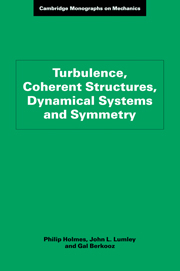8 - Randomly perturbed systems
Published online by Cambridge University Press: 03 February 2010
Summary
As we have described in Part I, attempts to build low-dimensional models of truly turbulent processes are likely to involve averaging or, more generally, modelling to account for neglected modes that are dynamically active in the sense that their states cannot be expressed as an algebraic function of the modes included in the model. Such models are in turn likely to involve probabilistic elements. Here, “neglected modes” may refer to (high wavenumber) modes in the inertial and dissipative ranges or to mid-range, active modes whose wavenumbers might be linearly unstable. They also may refer to spatial locations that are omitted, in selecting a subdomain of a large or infinite physical spatial extent. The boundary layer model of Chapter 9, for example, contains a forcing term representing a pressure field, unknown a priori, imposed on the outer edge of the wall region. While estimates of this term can be obtained from direct numerical simulations (e.g.), a natural simplification is to replace it with an external random perturbation of suitably small magnitude and appropriate power spectral content. More generally, many processes modelled by non-linear differential equations involve random effects, in either multiplicative form (coefficient variations) or additive form, and it is therefore worth making a brief foray into the field of stochastic dynamical systems to sample some of the tools available.
In this chapter we give a very selective and cursory description of how one can analyse the effect of additive white noise on a system linearised near an equilibrium point.
- Type
- Chapter
- Information
- Turbulence, Coherent Structures, Dynamical Systems and Symmetry , pp. 253 - 272Publisher: Cambridge University PressPrint publication year: 1996

